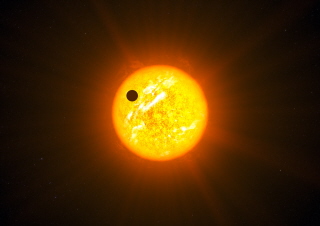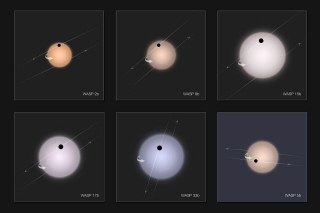Wrong-way planets do gymnastics
A group of planets that orbit the wrong way may have flipped over their stars.
Cartwheels aren’t just for gymnasts anymore — a gang of distant, unusual planets, a team of astronomers say, may have done giant, deep-space cartwheels to get into place. And those cartwheels are making scientists think again about what they know about planet formation.
These planets are unusual because they orbit, or move around their stars, backward. In the solar system, all eight major planets (sorry, Pluto!) move around the sun in the same direction: counter-clockwise when looking down on the sun’s north pole. The sun, too, is spinning in that direction.
Scientists believe that all the planets in the solar system were formed from the same giant disk of debris — mainly gas and dust — that was slowly moving around the sun billions of years ago. Since the debris was moving, the planets, including Earth, that formed also moved in the same direction as the debris.
 |
|
This image is from a video that illustrates a planet in retrograde orbit: The star is spinning to the right and the planet is rotating to the left. See the European Southern Observatory’s video.
|
| ESO, L. Calçada |
In addition, the paths of all the planets should be in the same plane. Imagine a giant, flat piece of paper that cuts through the middle of the sun and extends to the end of the solar system. If all the planets orbit in the same plane, then all their orbits will be on that piece of paper.
That’s the way it works in the solar system, so astronomers have wondered whether planetary systems around other stars work in the same way.
Last summer, astronomers found six planets moving around their host stars in the opposite direction. This finding suggests that scientists may have to think again about how planets form. All six of these planets are “hot Jupiters.” Hot Jupiters are giant — as big as or bigger than Jupiter — and orbit so close to their host stars that they’re blazing hot.
 |
|
Illustrated here are a few planets that orbit their stars in the wrong direction. The lower right image shows a planet orbiting in the same direction its parent star rotates.
|
| ESO, L. Calçada |
These six aren’t the only problematic planets. Some other recently discovered planets orbit in the forward direction around their host stars, but their orbital planes tilt at various angles.
At a recent meeting of astronomers in Glasgow, Scotland, Andrew Collier Cameron proposed an explanation for these wrong-way and tilted planets.
Cameron, an astronomer at the University of St. Andrews in Scotland, suggested that a much larger object —another star, or a giant planet, perhaps — may have come along. Gravity is a force that comes with mass, so planets or stars with more mass have more gravity, and thus a stronger pull on other objects. Large objects have strong gravitational forces, and these strong forces may have affected the way the planets move around their stars. Astronomers believe these forces can be so strong that they cause the planet’s orbit to flip like a jump rope over the star.
This effect, called the Kozai mechanism, may explain how a hot Jupiter ends up orbiting backward around its star. It may also explain how the other planets ended up with tilted orbits.
Cameron says the wrong-way planets match up with the change his team would have expected from the Kozai mechanism. “That looks very much like what we’re now observing,” Cameron says. “It looks almost too good to be true.”
Other scientists say it’s too early to say for certain whether the Kozai mechanism is responsible for the planets’ behavior. “Their data isn’t that definitive to eliminate any other possibilities,” Adam Burrows told Science News. Burrows is a scientist at Princeton University.
Astronomers have identified more than 400 exoplanets, and most of them are gas giants, like the hot Jupiters. (Exoplanet is short for “extra-solar planet,” which is a planet outside the solar system.) Astronomers would like to find a small, rocky planet not too far from or too close to its star — one that looks a lot like Earth. These types of planets are most likely to host life as we know it, so if we find an Earthlike planet, we may find life somewhere else in the universe.
Then again, we may not. If Cameron is right, then hot Jupiters on strange orbits may fling rocky debris — debris that would have made a small planet — out of the system. So in a way, more hot Jupiters may mean fewer Earthlike planets.
More studies are needed to know for sure why some planets run backward around their host stars.
Going Deeper:
Grossman, Lisa. 2010. “Backward planets may have flipped into place,” Science News, April 13. http://www.sciencenews.org/view/generic/id/58275/title/Backward_planets_may_have_flipped_into_place
Cowen, Ron. 2009. “Extrasolar planets at full tilt,” Science News, Sept. 12. http://www.sciencenews.org/index/generic/activity/view/id/46658/title/Extrasolar_planets_at_full_tilt
Ornes, Stephen. 2010. “Cool as a Jupiter,” Science News for Kids, April 7. http://sciencenewsforkids.org/articles/20100407/Note1.asp
Read all about the quest to find another Earth at NASA’s Planet Quest web site: http://planetquest.jpl.nasa.gov/







